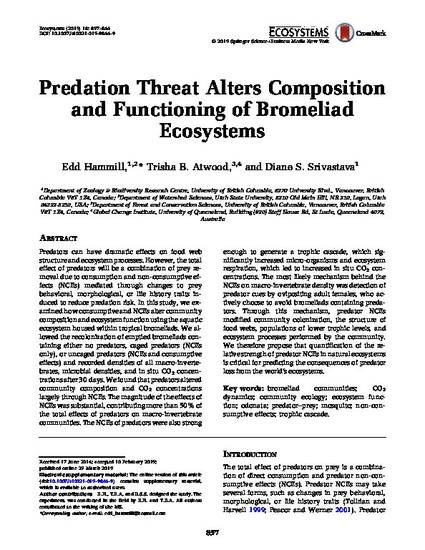
Article
Predation Threat Alters Composition and Functioning of Bromeliad Ecosystems
Ecosystems
(2015)
Abstract
Predators can have dramatic effects on food web structure and ecosystem processes. However, the total effect of predators will be a combination of prey removal due to consumption and non-consumptive effects (NCEs) mediated through changes to prey behavioral, morphological, or life history traits induced to reduce predation risk. In this study, we examined how consumptive and NCEs alter community composition and ecosystem function using the aquatic ecosystem housed within tropical bromeliads. We allowed the recolonization of emptied bromeliads containing either no predators, caged predators (NCEs only), or uncaged predators (NCEs and consumptive effects) and recorded densities of all macro-invertebrates, microbial densities, and in situ CO2concentrations after 30 days. We found that predators altered community composition and CO2concentrations largely through NCEs. The magnitude of the effects of NCEs was substantial, contributing more than 50% of the total effects of predators on macro-invertebrate communities. The NCEs of predators were also strong enough to generate a trophic cascade, which significantly increased micro-organisms and ecosystem respiration, which led to increased in situ CO2concentrations.
Disciplines
Publication Date
2015
DOI
https://doi.org/10.1007/s10021-015-9866-9
Citation Information
Edd Hammill. "Predation Threat Alters Composition and Functioning of Bromeliad Ecosystems" Ecosystems Vol. 18 Iss. 5 (2015) p. 857 - 866 Available at: http://works.bepress.com/edd-hammill/40/
